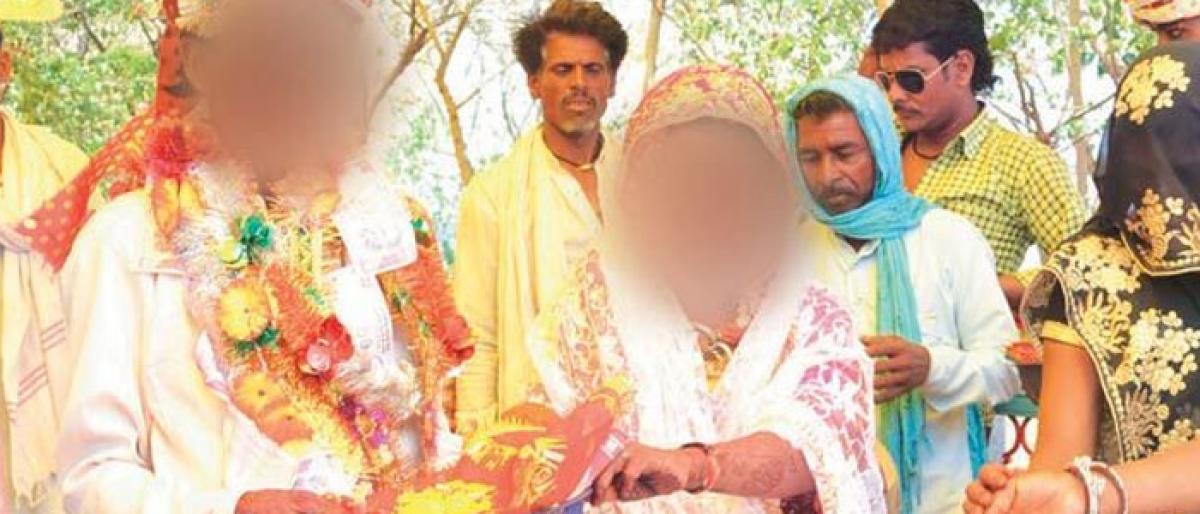Live
- Collector Inspires Students to Excel Through Discipline, Hard Work, and Smart Work
- District Collector Directs Officials to Expedite Paddy Procurement Process
- SP T. Srinivas Rao Inaugurates State-of-the-Art Volleyball Court for Police Personnel in Jogulamba Gadwal
- Geeta Jayanti Celebrations Organized at Maldakal Thimmappa Swamy Temple
- Indiramma Housing Scheme Survey Reviewed by District Collector
- Government Committed to Resolving ASHA Workers' Issues: Minister Damodar Raja Narasimha
- 'Refrain from interfering in municipal polls': Union Minister Ravneet Bittu tells Punjab officials
- SC grants anticipatory bail to accused in POCSO case
- Rising Rajasthan Summit to return in 2026, says CM Sharma
- Kerala HC issues contempt notice to official over elephant regulation violations
Just In

While all agree that child marriage should be abolished, it continues, including in Andhra Pradesh, where the most recent National Family Health Survey (NFHS-4 2015/16) shows that 33% of women in the age group of 20-24 were married before age 18.
While all agree that child marriage should be abolished, it continues, including in Andhra Pradesh, where the most recent National Family Health Survey (NFHS-4 2015/16) shows that 33% of women in the age group of 20-24 were married before age 18.
This has many insidious impacts. Girls that marry early typically stop going to school, meaning they receive less education, and are at a higher risk of domestic violence. In turn, their children receive less education. Child brides are much more likely to die in childbirth, and have worse health and nutrition, problems which are passed on to the next generation, who are more likely to be poor and unhealthy.
Clearly, outlawing the practice is not sufficient. Targeted policies are needed that will help a lot while remaining cost-effective. That is the goal of Reena V Mithal, PhD, Managing Partner of Sankhya Capital, in a new research paper for the India Consensus project Andhra Pradesh Priorities.
Andhra Pradesh has many challenges, and like any other state, there are never enough resources to do everything. What matters is where we can do the most good for each scarce rupee spent. That is why Tata Trusts, together with Copenhagen Consensus, initiated Andhra Pradesh Priorities.
The project held 18 Sector Expert Consultations in Vijayawada, Guntur, Visakhapatnam & Hyderabad, where more than 600 policies and ideas that would improve AP were discussed with over 220 experts. This helped find solutions to challenges which are important to the state and are worthwhile researching. This process identified dozens of solutions to study, including those that would reduce child marriage.
Experience shows that the most effective policy interventions to reduce child marriage are based on the economic empowerment of girls through secondary education. Dr Mithal examines four different policies that will reduce child marriage by boosting attendance at school for longer.
A typical barrier to girls’ schooling is a lack of transport. Secondary school is often much further away than primary school. Without transport, more girls will stay at home, and will marry early.
Giving each girl starting in secondary school a bicycle may seem like an odd way to reduce child marriage, but it has been tested and found effective in Muralidharan and Prakash.
The annual programme cost is Rs 386 crore, including the cost of bicyclesand the wages that girls forego by staying in school for longer. The policy will mean higher wages when girls graduate, because they will be better educated. Each year it will also mean 8,200 fewer girls child brides which has benefits for the girls, their children, and society. The bicycle will even save transport costs.
When all of these costs and benefits are compared, Dr Mithal finds that in Andhra Pradesh, each rupee spent on the policy will generate nearly Rs 12 in benefits to society, with the majority of these benefits coming from the increase in girls’ future wages and prosperity. A lack of appropriate sanitation facilities also makes girls more likely to drop out. A recent survey in Andhra Pradesh found that 30% have a toilet problem: 4% have no toilets, 15% are not sex separated, and 11% are unusable.
Solving the problem means building new toilets, separating boys and girls toilets, and repairing facilities. Those costs plus maintenance add up to Rs 130 crore on an annualised basis. Research shows the construction of a girls-only toilet increases upper primary school enrolment by 11%, increasing future wages, and reducing child marriage and all its attendant problems. In total, each rupee will generate Rs 12 of social good, meaning it is a very sound policy choice, just like the provision of a bicycle.
Dr Mithal also looks at using transfers to pay girls to attend school. This works well, but because it requires payments to everyone all the way through school, it is somewhat less effective, with a return to society of 5 rupees for every rupee spent. This new economic data provides new inputs for decision-makers, by highlighting the very strong returns that can come from investment in girls’ empowerment.
By: Dr Saleema Razvi & Dr BM Naidu
(Dr Saleema Razvi is Senior Research Advisor for the Andhra Pradesh Priorities project; Dr BM Naidu is Chief Consultant for India Consensus)

© 2024 Hyderabad Media House Limited/The Hans India. All rights reserved. Powered by hocalwire.com







